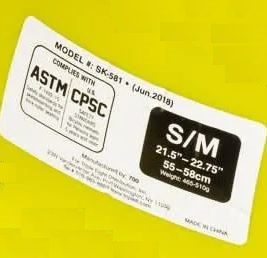Electric bikes are growing in popularity in the United States. While they were once rare, now you can see them while riding around town and you can even buy them in local stores now.
Protecting your head is a priority regardless of whether it is an electric bike or a pedal bike. It’s even more important on electric bikes because they are capable of going a bit faster than normal bikes.
Even though it’s a smart idea to buy and wear a bike helmet, it’s not necessary to wear a bike helmet everywhere and that’s the purpose of this article.
Electric Bike Classifications
Electric bikes are broken into one of three classes depending on capabilities and use, and that will go into determining if a bike helmet is necessary.
Class 1
Electric bikes in class 1 are pedal-assist only electric bikes with a maximum of 20 mph. They will give you some extra power and help make it a little easier to pedal.
Class 2
Electric bikes in class 2 are throttle-assisted bikes capable of up to 20 mph. They can drive entirely without you having to pedal at all.
Class 3
Class 3 electric bikes are ones that don’t fit into those two categories mainly because they are capable of over 20 mph.
These classifications determine what type of electric bike it is and what laws apply to it.
Federal Electric Bike Helmet Laws
There are no federal laws mandating the use of bike helmets on electric bikes. That makes sense since not all states require it either.
However, there are 2 federal agencies that do play a role in bike safety standards and regulations: the Consumer Product Safety Commission (CPSC) and the Department of Transportation (DOT).
The Consumer Product Safety Commission (CPSC)
The CPSC is an agency that regulates consumer product safety. That might be toys, and in this case it’s bike helmets.
They establish the safety standards (both how much it has to handle but also required safety labels) for new bike helmets. These same safety standards apply to the bike helmets themselves that electric bike riders wear.
Under the bike helmet safety standard 16 CFR Part 1203 the agency establishes safety standards for the helmets such as the minimum safety performance and construction requirements. All bike helmets have to meet these requirements to be sold in the United States. The helmets must also have a label station that they meet CPSC requirements.
Make sure any bike helmet you buy has the CPSC label so you know it will really protect your head.
The Department of Transportation (DOT)
The DOT, through the National Highway Traffic Safety Administration (NHTSA), regulates motor vehicles and vehicle equipment, including motorcycles.
Electric bikes (low-speed ones) are not considered motor vehicles under the law so the DOT has no say in regulations on them. However, they do work with states to help them out with their electric bike and helmet safety regulations.
But the DOT itself can not and doesn’t have any federal requirement to wear bike helmets on electric bikes.
State Electric Bike Helmet Laws
The states themselves have different electric bike helmet laws. Some states require it, some states don’t, and some states only require it under a certain age.
States with Mandatory Helmet Laws for All Electric Bike Riders
These states require ALL electric bike riders to wear a bike helmet while riding:
- California
- New York
- Massachusetts
- Maryland
- New Jersey
States with Age-Specific Helmet Laws for Electric Bike Riders
These states only require bike helmet for electric bike riders under certain ages:
- Connecticut: Helmets required for riders under 16
- Maine: Helmets required for riders under 16
- Rhode Island: Helmets required for riders under 15
- Florida: Helmets required for riders under 16
- Louisiana: Helmets required for riders under 12
- Pennsylvania: Helmets required for riders under 12
States with No Specific Electric Bike Helmet Laws
The other states such as Arizona and Colorado do not have specific laws requiring bike helmets for electric bike riders. It’s possible they have a general law about bike riding or scooters, etc, but nothing specific about electric bikes.
As always, check with your local offices to find out for sure.
The Importance of Wearing a Helmet While Riding an Electric Bike
Electric bikes can go much faster than normal bikes (generally), so protecting your head from a fall is extremely important. Statistics show that wearing a bike helmet can lower the chance of head injury by 60% which is pretty significant for such a simple thing to do.
The main protection from bike helmets is that it prevent blunt force trauma to the head. That may be riding under something and hitting your head, or it may be hitting your head on the curb after falling off the bike.
Riding a bike may seem simple but you’d be surprised how the wrong events can get you hurt too quickly.
So let’s jump to a lighter note. Many bike helmets also have a visor built in which will help block the sun when you are riding so you can less sun glare. Definitely a plus.
Bike helmets are cheap, and the amount of safety you get is undeniable. Riding an electric bike can be dangerous. Just get a helmet. That simple.
Choosing the Right Bike Helmet
Choosing the right bike helmet is very important because you are going to wear it and want to wear it every time you go out and ride.
Proper Fit and Sizing
A bike helmet should fit snug. Not tight where your head hurts. Not loose where it wobbles. It has to fit and move with your head to be the right fit.
To start with, measure around your head just above your eyebrows to get the circumference of your head. Use that with the manufacturer charts for the brand such as Bell or Giro to find the right helmet.
Ventilation and Comfort
When you get riding, you’ll get sweating. The more you can let air through the helmet to evaporate off the sweat, the less will drip down into your eyes. Most bikes have amazing ventilation and even moisture-wicking padding to help keep your head cool on those hot summer rides.
Safety Certifications
This is a really important one. This is the safety certification itself.
Every bike helmet sold in the United States is required to pass Consumer Product Safety Commission (CPSC) or American Society for Testing and Materials (ASTM) testing. It must also have a sticker on the helmet (usually on the inside) that shows that it passed. ONLY BUY A NEW HELMET IF THIS IS ON IT. It’s really that important because a cheap knockoff won’t protect you in a fall.
Even buying online anywhere, always make sure it has the sticker and has passed. Generally ones like Bell, Giro, Bontrager, and many more brands all do this well, but I have seen some on Amazon that were clearly not right which is why I’m calling so much attention to make sure everyone gets a bike helmet that will protect them properly.

This is an example of what the CPSC / ASTM safety sticker should look like on a bike helmet
Conclusion
In conclusion, many states have laws that require you to wear a bike helmet on an electric bike. Some require it for all, some require it for young riders, and some have no laws at all.
However, things change all the time so make sure you check with your local state office.
Actually, bike helmets are cheap enough I’m going to say that everyone at least should wear a bike helmet to protect themselves. You only have one brain, make sure you protect it so you can keep riding and of course reading my articles.
Also remember there is more equipment you’ll need than just a bike helmet. Beyond just safety equipment, you’ll want to bring some gear with you on a ride to ensure your bike can make it back if there is an issue.
Ride safely everyone!





